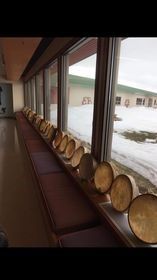By Dayna Thompson, Indigenous Visionaries Fellow

Reclaiming our birthright
I am a student at the White Earth Tribal and Community College and will graduate this coming spring. Outside of college, I serve on the Rice Lake Community Council and work in my chosen profession in addiction counseling. I always give back to my community, whether it’s with my job or volunteering. My vision for my community is that we all come together as one, focusing on our culture and language. I would like to focus my time by sharing my expertise with the community to help us revitalize our Ojibwemowin and culture.
Reclaiming the Sacredness of Women by Taking Back Their Power
Colonization and assimilation stripped Native women of their roles within the family, culture, and community. Today most Native women do not know their roles and/or teachings in the Ojibwe culture due to the legacy of boarding schools and the long history of cultural genocide.
Three Sisters water color painting by Lisa Brunner.
My project will host a women’s teaching circle for women in all stages of learning to come together and learn our teachings and roles for all women to share and learn from each other and to take back our power and reclaiming our sacredness as women!
Ojibwemowin, (Ojibwe language) is the foundation of our way of knowing as a people. Our understanding of self, as a society, our roles and relationship with each other, and our relationship with the land, elements, and animals are embedded in our language. My goal is to support not only Ojibwe language restoration in the community but also the restoration of the role of women within our society through our language.
Women in Traditional Leadership
Prior to colonization, women were heads of households and held high positions in the community. After colonization, women were no longer considered to be leaders. I am working to reclaim that role for women through this project. I hope that men and women can learn their teachings and roles to strengthen our culture and ways of life, including speaking/learning the Ojibwe language, ceremonies, teaching young women/girls, gathering medicines, beading, sewing, and more. Every single one of these cultural activities includes a cultural teaching.
Matriarchs
Anishinaabe women’s roles are planting and taking care of the garden.
Anishinaabe are a matriarchal society. We lived in balance with men, and lived in balance with Mother Earth and all that exists. Women are considered sacred because they give birth to our Nations and future generations. Historically children would take the clan of the fathers, the patriarchal lineage to create this balance within our society. This system was destroyed with colonization and assimilation, which is why we are working to restore this balance.
Nowadays leadership often falls in the laps of women, though it is expected for a man to take that role. Often men are still healing so our community relies and even expects to rely on the backbones of women, even while they take care of their families and are underappreciated.
I was taught and even encouraged that men should be taking leadership roles, not women. I tried to take leadership roles, and often when I did, it was because the community needed me. By following what was most natural to my ancestors, I was able to become the leader that I was destined to be.
Organizing the Women’s Talking Circle was powerful for me because we have so many teachings as daughters, sisters, mothers, aunties, and grandmothers. A friend once told me, “You’re the only friend I have that has a kid, so I am glad I have someone so close to me to be able to get advice from. We have so many insights that could be shared as well as insights that we can learn.”
Taking back our roles, culture and language represents “Standing in Our Power.” Many women grew up in the traditional lifestyle and some did not. As women, we should not gate keep our teachings. We need to share them, so we do not lose our ways. My goal is to continue these teaching/talking circles and start them in other communities. My end goal is to see our women gathering together as one, sharing teachings, holding ceremonies, and teaching each other how to sew, bead, or harvest medicines. I hope this project has a great impact on Indigenous women’s lives and we are able to revive our role as leaders in our communities.
